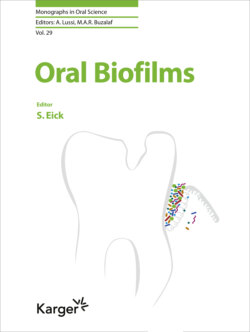Читать книгу Oral Biofilms - Группа авторов - Страница 18
На сайте Литреса книга снята с продажи.
Antibiofilm Therapy
ОглавлениеBiofilm-associated infections are extremely difficult to treat. For example, in the case of an orthopedic infection a two-stage revision is made. The infected artificial joint is removed and intermediately replaced by a spacer made of PMMA (polymethylmethacrylate) bone cements highly loaded with antibiotics, which should prevent renewed biofilm formation (Fig. 2).
The biofilm matrix serves as a barrier not only to antimicrobial agents but also to immune cells. Even if phagocytes can penetrate they are ineffective, and the release of intracellular compounds increases the density and integrity of the biofilm matrix [3]. In biofilms, bacteria may become more virulent through the exchange of genes, including resistance genes [3]. Most importantly, there are subpopulations of dormant bacteria with metabolically low activity that are non-subdividing and, following resistance against antimicrobials, require metabolically active cells [3].
According to the increased awareness of biofilm-associated infections, different approaches are under investigation. For several years, attempts have been made to prevent or to retard biofilm formation on medical devices. Whilst taking the side effects into account, antibiotics are prophylactically used to kill planktonic bacteria before they are able to form biofilms [23]. Antiadhesive biomaterials are developed by modification of the surface with biosurfactants, cold plasma, or the incorporation of antimicrobial-acting agents which might be in part released into the environment; however, the effectiveness is generally very limited [23]. Promising approaches seem to be the inhibition of quorum sensing or interfering with matrix constituents. Inhibitors of quorum-sensing molecules have been developed, and inhibitors of acyl-homoserine lactones significantly reduced P. aeruginosa biofilm formation in vitro [24]. Other possibilities are the dispersion of the biofilm matrix and targets are alginate, extracellular DNA, and proteins which might be degraded by polysaccharides, DNases, or proteinases [24].
